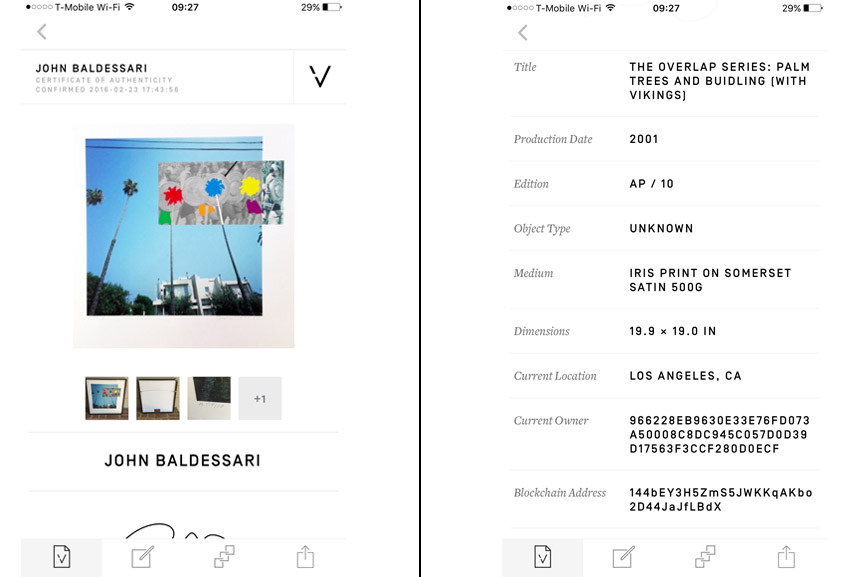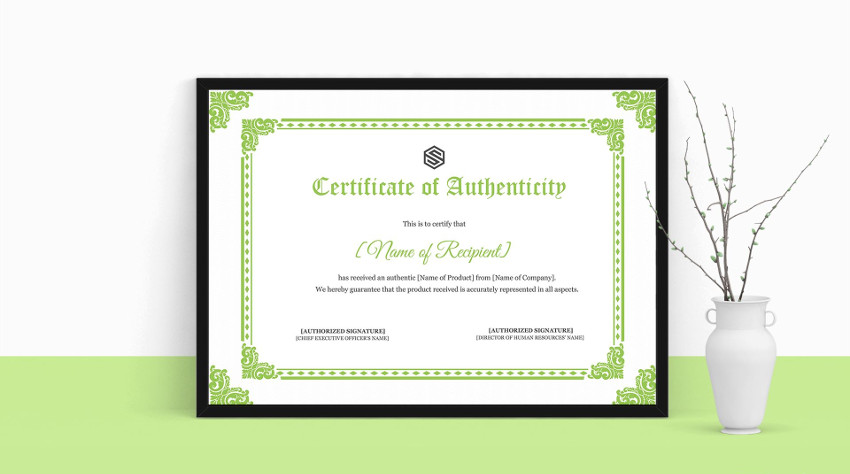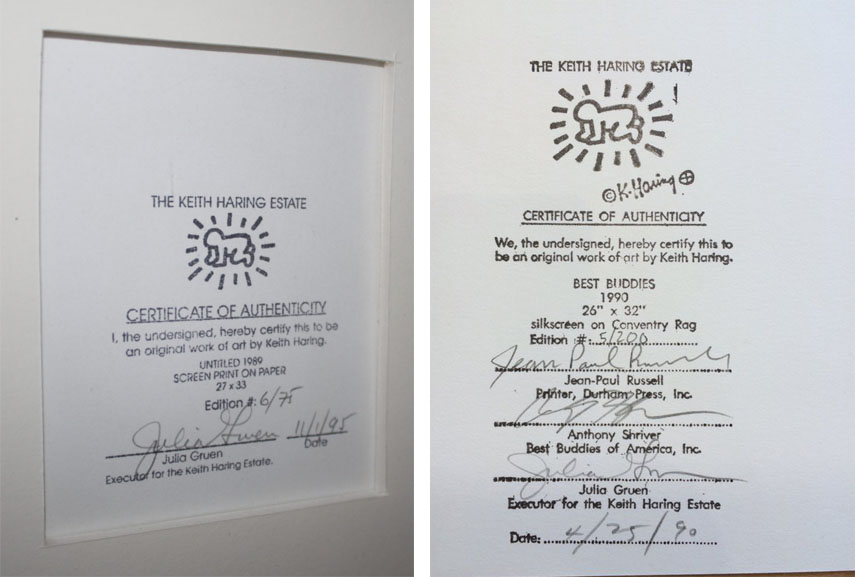Should I Reframe Art With a Certificate of Authenticity
Apart from offering humankind the possibility to express its imaginative and technical skills, art has also evolved to become proper trading business. Equally such, it has a market place of buyers and sellers, but it is the certificate of authenticity or COA that represents the most of import aspect of the circulation of artworks today. Over the last century in particular, the certificates have immune the works of fine art to be positioned every bit branded products, serving as their deeds, legal statements and fiscal invoices. However, as art itself shifted and developed, the certificate of actuality has as well, giving manner to a bountiful of forgeries in order to increase the sales. Fifty-fifty though the art world is still waiting for a universal, centralized database that could maybe be digital too, a genuine certificate of authenticity is nevertheless something that should back-trail every professional artwork out there, without exceptions, providing all the necessary information for the heir-apparent and holding the artwork'southward value.

What Is a Document of Authenticity in Fine art?
For any product we buy in general, nosotros demand some sort of document to prove its provenance, quality guarantee, the make or an individual that produced it. The certificate of actuality for an artwork is a document that contains these facts and information technology is essential for all sides of the merchandise. COA is created by the artist, or someone who is an expert of their oeuvre, to help the collectors prove it is genuine and verify its quality. In the earth of fine art, a piece accompanied by a certificate of actuality is 1 that is made past a professional, practicing art-maker, making a articulate distinction from amateur piece of work and attributing a potential collectable value to information technology. Simply put, the certificate provides credibility and it could be considered a promise that the piece in question is made of proper materials and is meant to last long in the easily of its new owner. Legally speaking, information technology declares the writer as indisputable and protects them from fraud and copyright infringement on an international level.

The Only Reliable Sales Receipt
A certificate of authenticity is usually provided at the time of sale, no matter whether it is bought from the artists themselves, other collectors or art institutions such every bit galleries, museums, institutes. It serves every bit the only reliable sales receipt, and not only should it exist present along with the piece - it should also be complete and contain all the information to draw the work in question. Without these two factors, many frauds observe space to create their ain, fake COA, specially when it comes to online art marketplace. In this example, it is important to mention that digital certificates are also valid, as long every bit they're as detailed and, well, 18-carat.

What Should a Genuine COA Include?
A valid certificate of authenticity in fine art comprises of specific details nearly an artwork. First of all, as mentioned before, the all-time author of a certificate is the creative person who made the piece of work. Notwithstanding, if this is to be someone else, then it is more likely their publisher, dealer or agent, someone who is a good connoisseur of their work and style. If this is the case, the COA should provide their name, full and current contact details and the nature of their relationship to the author. In whatsoever case, the writer of a certificate of authenticity should be traced easily at any moment, preferably by their location and websites, should a necessity for that arise. If there are people or companies involved in artistic production, they should exist cited as well. Side by side, in that location is the full, verbal title of the piece and the engagement of completion. Depending on the medium, there can exist dissimilar dates: for paintings and sculptures, for instance, at that place is the 1 date, while for prints and photographs, there is the date of completion of the original, the date of that particular impress edition, and the engagement of signing the print[1]. From these, fine art historians tin empathize the timeline of someone's career and give a better insight into their oeuvre.
Another important item of the certificate of authenticity is the medium, or all the materials used in the creation of the piece in question. The more precise these are, the more than they help their owner with conservation in society to ensure longevity and preserve quality; at the same time, they provide information on the creative procedure itself. For prints of original artwork in some other medium, both the medium of the original and the one of the print should be listed. This tin can include the type of pigment or ink, the printing device, blazon of canvas or paper, besides as source, weight and any pertinent or known archival properties. Preferably, the document should too comprise an image of the artwork equally well, for comparison. Next to this, we have the dimensions. If the artwork is framed, the certificate will likely land the dimension of the slice itself, as well as the size of it with the frame. If information technology is non, the precise information will help the owner choice the right frame. The buyer can also check whether the slice dimensions have been altered since its completion, in order to avoid fakes.
Finally, a certificate of authenticity should be sealed with the original signature of the author of the piece of work, followed by a copyright statement. It should reveal the copyright holder and peradventure the applicable law and reproduction rights likewise, if there are whatsoever. It is possible that the piece of work will be nether a public license or have some rights reserved; in this case, copying of the piece of work may be permissible. While the information listed so far could exist considered mandatory, what follows could be described every bit "extras": the names of reference books, magazines, or like resource that contain either specific or related information almost either that work of art or the artist; data on possible exhibitions, the techniques used to create the image, its subject matter, writer's comments on the piece…

Certificate of Authenticity for Prints
When it comes to unmarried pieces of art, the certificate of authenticity is easily defined. For prints or artworks that come up within an edition, in that location are a number of additional details that should exist noted. In these cases, the COA volition include the number of that particular impress within the edition and the edition size; if this is the quaternary print out of x, information technology volition say iv/10, letting us know that the edition is express. If information technology's is an open up one, on the other hand, meaning more pieces can exist produced at any time, this will exist stated as well. The document should also provide information on the number of prints and proofs inside that are signed and numbered, only signed or just numbered; whether the edition is a restrike or posthumous; whether information technology is a part of a series of editions, such as artist proof, printing proof, transfer, etc.; the status of the plate or master, such every bit whether it is destroyed or on file - if the main has been destroyed, the edition truly is limited; and then on. If the printmaker is non the artist themselves, their signature should be nowadays likewise.
All limited edition prints past well known artists are documented in books called catalogue raisonnée. If such a book exists for a sure individual, the corresponding catalogue number or entry for artwork in question is noted on its certificate of actuality. Apart from this, there could also be data on previous owners, names of dealers, galleries and even auctions that sold it.

Avoiding the Risks every bit Both an Creative person and a Heir-apparent
Certificates of authenticity in art have often caused controversy in the by few years, due to online auction sites where sellers are providing fake COAs to market or sell their artworks. Because currently there is no official body or legal bounden for these documents, it is important the buyers inspect them thoroughly before the purchase. Furthermore, non all COAs are created equal: nowadays, an artist could get a complimentary template on the web to create the certificate, which is besides considered valid, just it is the buyer's responsibility to make sure it contains all it should. Many fake documents have no contact details of the person selling the item - or if they do, they're incorrect or misleading. The buyer should also never accept an incomplete or photocopied certificate or illegible signatures or information in general. If the information provided is in any way indirect, conditional or assumptive, containing phrases such as "in our considered stance..." or "we believe that…", such slice of paper should be avoided, as the just valid COA is one stating conclusively that the art is by the author whose signature it bears[2]. Even though the offence of issuing such certificates is punishable past law and fifty-fifty carries prison sentence, information technology is always recommendable to exist safe than lamentable, which is why buyers, and artists, are e'er advised to take the risks to a minimum in a joint effort, and proceed the integrity and value of artworks at a level they rightfully deserve.
References:
- Hapgood, S., Lauf, C., In Deed: Certificates of Actuality in Fine art, Roma Publications, 2011
- Bamberher, A., Is Your Document of Authenticity Worth the Paper It'southward Printed On?, ArtBusiness.com [December 7, 2016]
Featured images: A COA for Roy Lichtenstein'south Brushstroke artwork. Epitome via eBay; From Andy Warhol Catalogue Raisonné Collection, image via phaidon; An example of COA for Norman Rockwell, issued by Park Westward Gallery. Image via eBay. All images used for illustrative purposes only.
cornwellwitir1949.blogspot.com
Source: https://www.widewalls.ch/magazine/certificate-of-authenticity
0 Response to "Should I Reframe Art With a Certificate of Authenticity"
Post a Comment